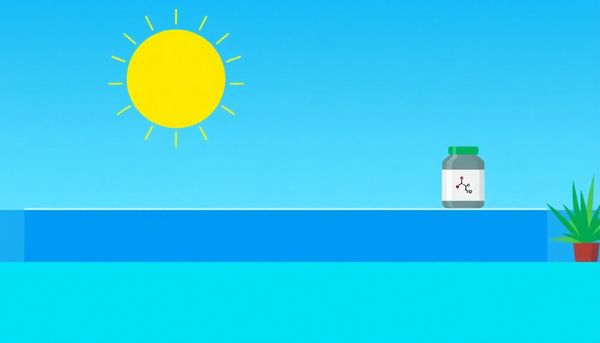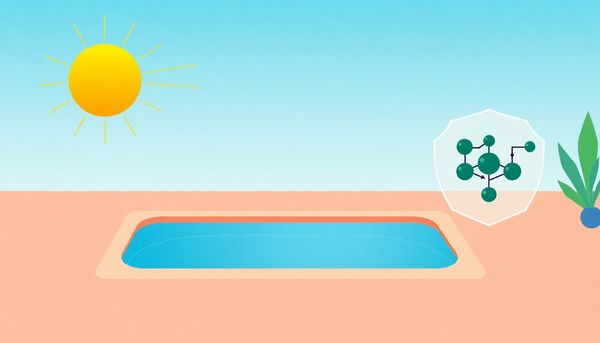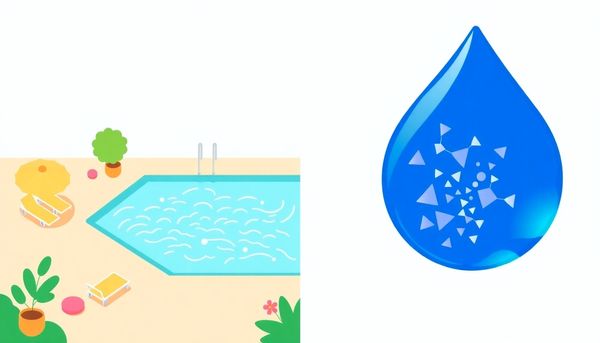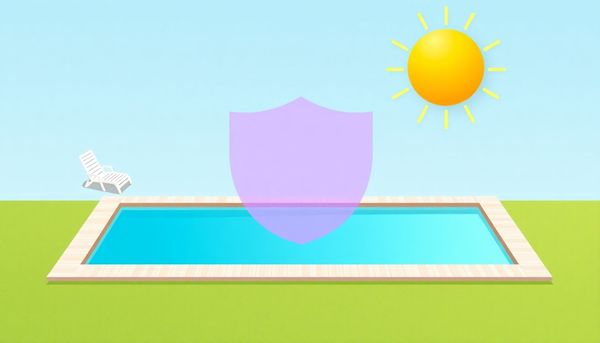Optimize Pool Health: Master Cyanuric Acid Balance
August 17th, 2024
August 17th, 2024
Sunny days often lead to thoughts of relaxing by the pool, the inviting water promising refreshment and fun. Yet, few consider the hidden complexities that keep that water safe and sparkling. Enter cyanuric acid, an unsung hero of pool maintenance. This chemical stabilizer may not be the first thing on your mind when you think about swimming, but it plays a crucial role in preserving the pool’s health.
In essence, cyanuric acid acts as a shield for chlorine, protecting it from the harsh effects of the sun’s ultraviolet rays. By doing so, it extends the life of chlorine, ensuring it remains effective in combating bacteria and algae. Without it, chlorine dissipates quickly, leaving the pool vulnerable to contamination. This is especially vital in outdoor pools exposed to constant sunlight, where chlorine can vanish in a matter of hours.
Balancing cyanuric acid is not just about adding it to the water; it requires understanding the right levels. Too little, and the chlorine evaporates too quickly. Too much, and it can cause a condition known as "chlorine lock," where chlorine becomes ineffective. My neighbor learned this the hard way. After struggling with murky water despite dumping in gallons of chlorine, he discovered his cyanuric acid levels were sky-high. Regular testing and adjustments made all the difference, transforming his pool back into the neighborhood oasis it was meant to be. Understanding cyanuric acid's role can save time, money, and frustration, ensuring your pool remains a pristine and inviting retreat.

Chlorine's superhero potential in keeping pools pristine is often thwarted by its kryptonite: ultraviolet rays. Enter cyanuric acid (CYA), the unsung hero that ensures chlorine’s strength isn’t sapped by the sun. Think of CYA as a sunscreen for chlorine, preserving its ability to sanitize effectively. Without it, you can kiss goodbye to your pool’s protective layer in no time.
In my own backyard pool, forgetting to stabilize chlorine once led to an algae bloom that took weeks to clear. It was a costly reminder of CYA’s importance. The balance, however, is crucial; too much CYA, and your chlorine becomes lethargic, unable to fight off contaminants. It’s like giving your pool water a full suit of armor but dulling its sword. Proper CYA levels, ideally between 30 and 50 ppm, are vital. This range allows chlorine to function optimally without being bullied by the sun or hamstrung by excess stabilizer.
On the flip side, for saltwater pool aficionados, the stakes are slightly higher, requiring CYA levels from 60 to 80 ppm to offset the dual assault on salt and chlorine by UV rays. Keeping an eye on these levels means your pool remains a sparkling haven, ready for impromptu swims and sun-drenched afternoons. Regular testing ensures that the balance is struck, keeping both your pool and wallet in good health.
Maintaining optimal levels of cyanuric acid (CYA) in your pool is akin to finding the perfect balance in a recipe; too little or too much can ruin the outcome. Pool owners often underestimate the importance of this delicate equilibrium. Think of CYA as your pool’s sunscreen; without it, chlorine evaporates quickly under the relentless sun, while too much can reduce chlorine’s ability to keep your pool clean.
Start by regularly testing your water. Test strips or liquid test kits specifically designed for CYA are essential tools in your pool maintenance arsenal. Aim for levels between 30 and 50 ppm for conventional pools. Those with saltwater systems should aim higher, between 60 and 80 ppm, as recommended by manufacturers due to increased vulnerability to UV rays.
If you find your CYA levels are creeping too high, it might be time to partially drain your pool. This process involves removing a portion of the pool water and replacing it with fresh water, thereby diluting the concentration of cyanuric acid. Remember, CYA doesn’t evaporate like chlorine; it stays put, making high levels tricky to manage.
Conversely, if your levels are low, adding a stabilizer will help. These products are often sold under names like “pool conditioner” and are crucial for maintaining that protective layer of CYA. Keep a watchful eye on your pool’s chemical balance, and your water will remain clear and inviting all season long.
In the world of pool maintenance, the interplay between cyanuric acid (CYA) and ultraviolet rays is crucial. Think of CYA as a sunscreen for your chlorine; without it, UV rays swiftly degrade chlorine, causing it to vanish before it can do its vital job. This translates to a pool constantly needing chlorine refills, which can be both costly and inefficient.
When I first started maintaining my own backyard pool, I was baffled by how often I needed to add chlorine. I remember a particularly sunny week where I added chlorine on a Monday only to find barely any left by Thursday. The culprit was the relentless UV exposure, and the solution was a sufficient level of CYA. Ideally, outdoor pools benefit the most from CYA, as indoor ones are usually shielded from direct sunlight.
However, balance is key. Too much CYA can lead to “chlorine lock,” where chlorine becomes less effective, opening the door to algae growth and murky water. To prevent this, regular testing ensures that CYA levels remain within the sweet spot of 30 to 50 ppm. For saltwater pools, this range shifts slightly higher due to the dual impact of UV on both salt and chlorine. By maintaining the right levels of CYA, pool owners can protect their investment and enjoy clear, clean water all season long.
If you’ve ever found yourself in the middle of a pool chemical mishap, you know how crucial it is to play it safe with substances like cyanuric acid (CYA). As a key player in maintaining your pool’s cleanliness, it's vital to manage this chemical with care. Let's explore how to handle CYA safely, drawing from practical experience and expert advice.
First, picture the scene: a dust plume rising as you pour the powder. This might look like a dramatic science experiment, but it's not the safest approach. Always use protective gear—think acid-resistant gloves and goggles—to shield yourself from potential irritations or burns. Remember, better safe than sorry!
When it comes to adding cyanuric acid, slow and steady wins the race. Opt for a bucket method: dissolve the powder in a large bucket of warm water, stirring until it’s completely dissolved. This way, you prevent clumps that can damage pool surfaces, especially delicate vinyl liners. Once dissolved, pour the solution evenly around the pool, ensuring a balanced distribution.
Ventilation plays a crucial role, too. Handle CYA in open spaces where air circulates freely to avoid inhaling harmful fumes. If your pool is indoors, ensure windows and doors are open to facilitate airflow.
Regular testing can be your best friend. Weekly checks keep you informed about CYA levels, preventing the all-too-common trap of over-stabilization. With these practices, your pool can remain both a haven of relaxation and a paragon of safety.
Managing the delicate balance of cyanuric acid (CYA) in your pool is akin to finding the right seasoning for your favorite dish. Too little, and your chlorine dissipates under the sun’s relentless glare. Too much, and you've over-seasoned, rendering your chlorine almost ineffective. The art lies in maintaining that perfect middle ground—where chlorine can thrive, actively sanitizing your pool without being overpowered by excess CYA.
Consider a warm summer day, when your pool is the center of family fun. Kids dive in and out, laughter fills the air, and the last thing you need is a sudden algae bloom due to improper CYA levels. Regular testing ensures that CYA stays between 30 and 50 ppm, letting chlorine efficiently do its job. Grab a test strip and make it a routine—much like checking the gas gauge before a long drive.
When CYA levels do creep too high, the solution isn't found in a bottle but in a garden hose. Partially draining and refilling the pool is the most effective way to dilute high CYA levels. It's like resetting to a clean slate. This might sound daunting, but it’s a small price for a crystal-clear oasis. Remember, balance is key. With proper management, CYA can be your pool’s best friend, ensuring a fresh and inviting swim, no matter how scorching the sun.
Balancing cyanuric acid (CYA) levels in your pool is like trying to find the sweet spot in a recipe—you want just enough to enhance the flavor but not so much that it overwhelms everything else. Too much CYA can make your pool water cloudy and reduce the effectiveness of your chlorine, letting algae and bacteria throw a pool party on your watch. On the flip side, too little and your chlorine's gone faster than ice cream on a hot summer day.
The first step in managing CYA levels is understanding what you're dealing with. Regularly test your pool water to ensure your CYA levels hover between 30 and 50 parts per million (ppm) for standard pools. If you're tending to a saltwater pool, aim slightly higher, between 60 and 80 ppm. You don't need fancy gadgets—a simple test kit will do, or visit a local pool supply store for a professional checkup.
Should you find your CYA levels creeping up, there's no quick fix. Dilution is your best friend. This might mean partially draining your pool and topping it up with fresh water—a bit of a hassle but effective. If water conservation is a concern, CYA reducers might be an option, though they can be hit or miss and often pricier than a hose job.
On the other hand, when your CYA levels are too low, adding a stabilizer can help. Choose a product carefully, and remember that many chlorine tablets already contain CYA, so you might be adding it without realizing. Always read the labels. Regular monitoring and adjustments will keep your pool crystal clear, inviting, and ready for a dip whenever you are.
Checking a pool's chemical balance can feel somewhat like keeping tabs on a mischievous pet; it requires regular attention and a bit of intuition. With cyanuric acid (CYA), the task becomes even more crucial. This unsung hero of pool maintenance protects your chlorine from vanishing under the relentless sun, but it demands careful monitoring to perform effectively. Neglecting regular testing can lead to an uninviting pool, where your chlorine struggles to sanitize effectively or algae begin to make themselves at home.
My neighbor, always eager to show off his pristine pool, swears by his weekly ritual. Every Saturday morning, he pulls out his trusty test kit, a quick and easy tool that measures CYA levels alongside other vital chemicals. Within minutes, he knows whether adjustments are needed to keep his pool at the perfect 30-50 ppm range. This simple routine not only prevents potential chemical imbalances but also saves him the headache of more complex adjustments later.
After a heavy summer rain, pool chemistry can shift unexpectedly. Rainwater might dilute your cyanuric acid levels, necessitating a recheck. Similarly, if your pool has been heavily used or you've faced a particularly sunny week, a quick test ensures your chlorine continues to do its job. Embracing this consistent testing habit keeps your pool inviting and safe, allowing for carefree swims under the sun.
Choosing the right chlorine for your pool is akin to selecting the perfect seasoning for your favorite dish. Just as a pinch of salt can transform a meal, the right type of chlorine can make all the difference in maintaining crystal-clear water. With so many choices on the market, it's essential to understand how each type interacts with cyanuric acid (CYA) to ensure your chlorine remains effective.
Consider stabilized chlorine, like trichlor or dichlor, which comes with CYA already blended in. These options are particularly handy for outdoor pools, providing an extra layer of protection against the sun’s relentless UV rays. Every time you add these products, you’re not only topping up your chlorine but also reinforcing your pool’s defense against rapid chlorine depletion. This dual action is a boon for those who prefer a hands-off approach to pool maintenance.
However, if your CYA levels are creeping too high, unstabilized chlorine is your best ally. Liquid chlorine, for example, allows you to control CYA levels more precisely, as it doesn't contribute additional stabilizer. This flexibility is especially beneficial when you need to adjust CYA without affecting chlorine levels.
Understanding these nuances can save you time, money, and countless headaches. By selecting the appropriate chlorine type for your specific needs, you'll keep your pool in perfect harmony, ensuring every swim is as refreshing as the last.

Under the blazing summer sun, your pool might feel like a refreshing oasis, but the sun is also working against you, breaking down pool chlorine faster than you can say "swim time." Here, cyanuric acid (CYA) steps in as your invisible shield. Acting as a sunscreen for your chlorine, CYA ensures it remains effective longer, sparing you from frequent chemical top-ups and potential water quality issues.
Imagine relying solely on sunscreen without reapplying—your skin would soon protest. Similarly, without CYA, your chlorine's potency decreases rapidly, leaving your pool vulnerable. A friend once shared their frustration about endless algae blooms despite regular chlorination. A simple CYA test revealed levels below 30 ppm, and once adjusted, their pool stayed clear and inviting throughout the season.
Balancing CYA levels is akin to seasoning a dish—you need just the right amount. Too little, and your chlorine evaporates like morning mist; too much, and its effectiveness plummets, potentially leading to cloudy water and stubborn algae. Maintaining CYA between 30 to 50 ppm for standard pools, or slightly higher for saltwater pools, is crucial to harnessing its full protective power.
Stay vigilant. Regular testing, especially after heavy rain or water changes, will help maintain this balance. By managing CYA, not only do you extend the life of your chlorine, but you also keep your pool in pristine condition, safeguarding both swimmers and your investment.
Balancing cyanuric acid (CYA) in your pool isn't just a routine task; it's essential for maintaining a clean and safe swimming environment. Dealing with the right CYA levels can feel like walking a tightrope—too little, and your chlorine evaporates in the sun; too much, and your pool becomes a haven for algae. Imagine the frustration of adding endless chlorine without seeing any improvement in water clarity. Hence, knowing how to maintain optimal CYA levels is invaluable for any pool owner.
To keep CYA levels in check, regular testing is crucial. Invest in reliable test strips or liquid test kits that measure CYA alongside other key pool chemicals. Weekly checks can help you stay ahead of potential issues, such as high CYA concentrations that compromise chlorine effectiveness. Last summer, after neglecting this step, my pool turned cloudy, proving firsthand how vital consistent monitoring is.
Additionally, understanding your chlorine choice impacts CYA levels. Stabilized chlorine products, like trichlor tablets, already contain CYA, meaning each dose subtly raises your pool’s CYA level. I once switched to unstabilized chlorine after realizing my CYA was creeping too high, and it made a noticeable difference. If you find CYA levels surging beyond the ideal 30-50 ppm range, diluting your pool with fresh water remains the most efficient correction method. Remember, a balanced approach ensures your pool stays a refreshing oasis rather than a troublesome chore.
When it comes to maintaining the delicate balance of your pool's chemistry, using stabilized-chlorine products can be your secret weapon. These products, such as trichlor or dichlor granules, come pre-loaded with cyanuric acid (CYA), which means each time you add chlorine, you're simultaneously boosting your pool's defense against the sun's ultraviolet rays. This not only extends the life of your chlorine but also ensures your pool remains a safe haven for swimming.
Consider the convenience of stabilized chlorine like having a built-in sunscreen for your pool. For those who have outdoor pools, especially in sunny climates, this can make a significant difference. Without CYA, your chlorine would rapidly dissipate, requiring frequent replenishment and turning pool maintenance into a never-ending task. Stabilized chlorine eases this burden by ensuring that your chlorine sticks around longer, reducing both effort and cost.
In my own experience, swapping to stabilized chlorine transformed my pool upkeep routine. Instead of constant monitoring and adjustments, I found myself spending more time enjoying the water rather than testing it. However, like any good thing, moderation is key. It's crucial to keep an eye on your CYA levels to avoid over-stabilization, which can lead to cloudy water or reduced chlorine effectiveness. Simple, regular testing can prevent these issues, allowing you to savor your pool without the stress.
Sunlight, for all its warmth and brilliance, has a knack for spoiling your pool party by evaporating chlorine almost as soon as it arrives. Yet there’s an unsung hero in the world of pool care that steps up to keep the fun afloat—cyanuric acid (CYA). This unassuming compound acts as a protective shield, fending off the sun’s ultraviolet rays and allowing chlorine to remain effective for a longer time. Without it, you’d be caught in an endless cycle of adding chlorine, only to watch it vanish in the midday sun.
Understanding the delicate dance between CYA and chlorine is crucial. Too much CYA, and you’re facing a different beast: a pool where chlorine becomes lethargic, allowing algae and bacteria to crash your poolside joy. Picture a friend who always overstays their welcome—that's what excess CYA does to your pool environment. Maintaining CYA levels between 30 and 50 ppm ensures that chlorine can do its job without being overwhelmed.
For those fortunate enough to own a saltwater pool, the rules shift slightly. Saltwater systems require higher CYA levels, somewhere between 60 and 80 ppm, to counteract the UV rays. A smart practice is to regularly monitor your pool’s chemistry with a reliable test kit. By keeping a close eye on CYA levels, you create a balanced environment that allows chlorine to thrive, ensuring your pool remains a refreshing oasis, not just a sun-drenched basin.

There's something almost magical about the delicate balancing act required to maintain a pristine swimming pool. Cyanuric acid (CYA), the unsung hero of pool chemistry, plays a crucial role in this balance, acting as a shield for chlorine against the sun’s harsh ultraviolet rays. However, like seasoning a soup, finding the right amount is key—too little, and your chlorine dissipates rapidly; too much, and the chlorine's efficacy diminishes, allowing contaminants to thrive.
Imagine a sunny afternoon when you're ready to enjoy your pool, only to discover cloudy water and a faint green hue. This could be the result of excessive CYA. Chlorine becomes less efficient with high CYA levels, leading to potential algae blooms. It’s a lesson I learned the hard way during my first summer as a pool owner, as I frantically tried to rid my pool of stubborn algae. The culprit? A sky-high CYA level from using too much stabilized chlorine.
To keep your pool's chemistry in harmony, aim for CYA levels between 30 and 50 parts per million (ppm). For saltwater pools, the sweet spot is slightly higher, around 60 to 80 ppm. Regular testing is essential. If levels creep too high, the simplest remedy is dilution: partially draining and refilling the pool with fresh water. By maintaining this balance, you'll ensure your pool remains a sparkling oasis throughout the season.
On a warm summer day, the family pool beckons with promises of cool relief and fun. However, beneath the shimmering surface lies a delicate dance of chemistry that keeps your pool not only inviting but safe. One of the unsung heroes of this aquatic balance is cyanuric acid (CYA), the guardian of your chlorine. While its role in shielding chlorine from the sun's relentless UV rays is vital, keeping your CYA levels optimal is the real challenge.
First off, understanding your pool's unique needs is crucial. Outdoor pools are particularly susceptible to chlorine loss due to sunlight, and that's where CYA steps in. But too much of a good thing can backfire; excessive CYA levels reduce chlorine's ability to sanitize, leading to potential problems like algae blooms and cloudy water. Therefore, maintaining CYA levels between 30 and 50 parts per million (ppm) is often the sweet spot for most pools. Saltwater pool aficionados might need slightly higher levels, up to 80 ppm, due to the dual impact of UV rays on both salt and chlorine.
Regular testing becomes a ritual. Weekly checks with reliable test strips or kits ensure your pool chemistry remains balanced. I recall a neighbor who, despite regular chlorine additions, battled persistent cloudiness simply because of unchecked CYA levels. A quick test revealed levels over 100 ppm, necessitating a partial drain and refill—a simple yet effective remedy to recalibrate the pool's chemistry.
Thus, understanding and adjusting CYA levels is less about complex science and more about routine care. With a bit of attention, your pool can remain a sparkling oasis all season long.
Balancing the chlorine-stabilizer ratio isn't merely a numbers game; it's a keystone of pool maintenance that ensures both safety and efficiency. The delicate dance between chlorine and cyanuric acid hinges on more than just adding or subtracting chemicals. The right balance can make the difference between a sparkling oasis and a murky puddle.
I remember a summer when my pool turned from a clear blue haven to a green, algae-infested swamp. I had been adding chlorine like clockwork but neglected to monitor the cyanuric acid levels. I learned the hard way that when CYA levels skyrocket, chlorine's sanitizing prowess plummets. High CYA levels, sometimes over 100 ppm, can create a scenario where chlorine is present but unable to effectively combat bacteria, leading to unexpected outbreaks of algae.
To find harmony, begin with accurate testing. Kits are available that measure both free chlorine and CYA levels. Your target is that sweet spot where the free chlorine levels are approximately 7.5% of your cyanuric acid concentration. For instance, with a CYA level of 40 ppm, aim for a free chlorine level of about 3 ppm. It's important to switch to unstabilized chlorine if CYA levels creep too high, to prevent exacerbating the imbalance.
Finally, if your pool's CYA levels are beyond control, a partial water drain and refill could be your only solution. It’s a straightforward yet crucial task, well worth the effort, to bring back the perfect aquatic equilibrium. Each adjustment, each test, brings you closer to a pool that’s not only safe but inviting.
Maintaining a perfect balance of cyanuric acid (CYA) in your pool can seem like walking a tightrope. Allowing levels to soar too high can spell trouble for your chlorine’s performance, akin to a micromanaging boss stifling an otherwise capable team. A proactive approach can prevent the headaches of high CYA accumulation, ensuring your pool remains a sparkling oasis.
Start by knowing where your CYA levels stand. Regular testing, especially if you’re using stabilized chlorine, is key. Think of it like checking your car’s oil – essential for smooth operation. Opt for test strips or liquid test kits that accurately measure your CYA levels, ideally keeping them within the 30 to 50 ppm sweet spot for most pools. Should levels creep higher, consider switching to unstabilized chlorine temporarily. This allows you to continue sanitizing without adding more CYA, much like cutting back on sugar but still enjoying dessert.
Remember the golden rule: more isn’t always better. Resist the temptation to overdo it with CYA. If levels do climb too high, partial water replacement might be necessary. It’s similar to refreshing a room by opening a window rather than masking odors with air freshener. Finally, keep an eye on rainfall and splash-out, natural events that can inadvertently help manage your pool's chemistry by diluting CYA levels. Embrace these moments as nature’s gift to your pool’s ecosystem.

Sunshine on a lazy afternoon by the pool sounds delightful, doesn't it? But it’s not all fun and games for your chlorine. The sun’s ultraviolet rays can degrade chlorine in a flash, leaving your pool vulnerable to bacteria and algae. Think of cyanuric acid (CYA) as your chlorine’s sunscreen, shielding it from those relentless UV rays.
One scorching summer, I noticed my pool's chlorine levels were dropping faster than my phone's battery. After a bit of research, I realized my outdoor pool was missing its crucial ally—cyanuric acid. Without it, my chlorine was evaporating as quickly as ice cream on a July sidewalk, leaving the water vulnerable and unsanitary.
CYA acts as a protective barrier, ensuring your chlorine doesn't vanish under the sun’s gaze. With proper CYA levels, your chlorine can hang around longer, effectively keeping your water clean and safe. However, too much of a good thing can backfire; overdoing CYA reduces chlorine’s power, leading to a murky pool. Striking the right balance is key—ideally, between 30 and 50 parts per million (ppm) for most pools.
Remember, your pool deserves a break from UV stress, just like we do with sunscreen. So, keep a close eye on those CYA levels. A balanced pool is just a few careful adjustments away from becoming your sanctuary from the summer heat.
Balancing cyanuric acid in your pool is akin to mastering the art of seasoning a dish; too little, and your chlorine evaporates under the sun, too much, and your chlorine loses its fighting spirit against contaminants. Years ago, I learned this the hard way, watching my pool water turn a murky green despite generous chlorine doses. This happened because my CYA levels were off the chart, reducing chlorine's effectiveness to tackle algae and bacteria.
To keep your pool water pristine, ensure your cyanuric acid levels hover between 30 and 50 ppm. This sweet spot allows chlorine to perform its sanitizing magic while being shielded from the sun’s harsh UV rays. For saltwater pools, you might need a higher range, around 60 to 80 ppm, due to the compounded effects of UV on salt.
Testing your pool's CYA levels weekly is a habit worth forming. It’s much easier to prevent a problem than to fix one, especially when excess CYA can only be reduced by partially draining your pool. If you’re using stabilized chlorine, remember it already contains CYA, so adjust your additions accordingly. Several times each season, check your water chemistry, especially after heavy rainfall, which can dilute CYA levels.
Approach CYA adjustments with caution; it’s a chemical that likes to stick around. Whenever you need to add it, mix it thoroughly in a bucket of pool water before gently pouring it into your pool, lest it causes damage to your filtration system. Treat your pool like a cherished garden—regular care and a balanced approach will yield clear, inviting waters ready for any splash.
Testing and adjusting the cyanuric acid (CYA) levels in your pool is akin to fine-tuning a musical instrument; it requires precision and regular attention. In my early days of pool ownership, I underestimated the significance of this balance. I remember a particularly sunny week when my pool water turned murky despite regular chlorine use. The culprit? Sky-high CYA levels that rendered my chlorine ineffective.
Begin by assessing your pool's CYA levels with a reliable test kit. Aim for a range of 30-50 ppm for standard pools, and 60-80 ppm if you're dealing with a saltwater pool. Regular testing ensures that you're not shooting in the dark. If your CYA levels are above the desired range, it might be time to partially drain your pool and refill with fresh water. This method is straightforward but also an invaluable solution for diluting excess cyanuric acid, which stubbornly refuses to evaporate.
In contrast, if your levels are too low, adding a pool stabilizer is a must. However, proceed with caution—adding too much can lead to the same problems you’re trying to avoid. Always double-check that you’re using the right type of chlorine, as stabilized varieties already contain CYA. My neighbor once learned this the hard way, spending an entire afternoon adjusting his pool chemistry after mistakenly adding more stabilizer than needed. The key takeaway? Consistency in monitoring and a clear understanding of your pool’s needs.

This article provided insights into maintaining your pool. Start your pool care journey today!
Want to become a pool maintenance expert? Our free Pool School course covers everything you need to know about pool care. From basic maintenance to advanced troubleshooting, you'll learn how to:
Join over 10,000 pool owners who have already transformed their pool care routine. Get started with our free Pool School course today!